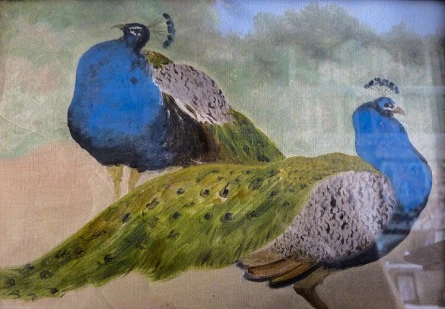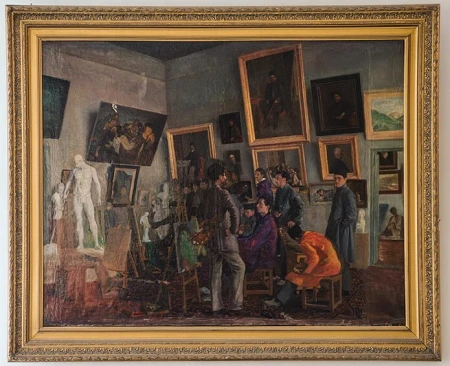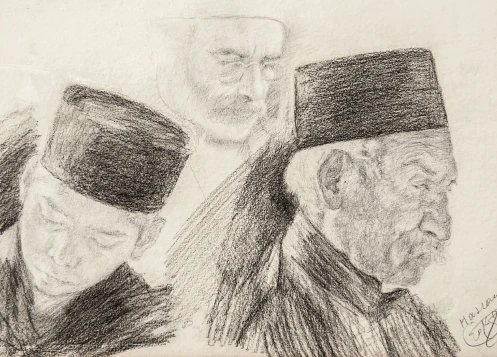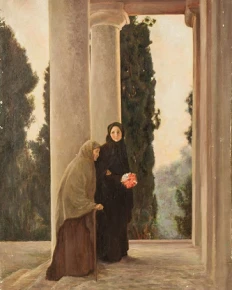Hassan Ali Khan Vaziri
Maintaining the current collection, including paintings and documents of Hasan Ali Khan Wazir, Is due to the efforts and compassionate care of Mr. Iraj Teimouri, Master's son in law.
About
Hasanali Vaziri (24th Feb. 1890-23th Nov. 1954) was an Iranian Painter and sculpter of the school of realism. He was one of the first student of Kamaml Almolk (prominent Iranian painter) at the School of Fine Arts in Tehran. Hasanali and his piers were the first realist painters of Iran. At the time that all other artists were still adhered to classic style Hasanali in his painting of the School Registrar introduced an new style which was lenient toward Impressionism. He grew up in a family of well educated artists and scholar of Tehran. His mother was one of the first female journalist and also the founder of the first primary schools in Iran. Hasanali went to military school for few years but he quitted it before graduation to join the newly established School of Fine Arts by Kamal Almolk to study painting.



After graduating from that school he was appointed as a teacher and principal at the school. He was then promoted to the deputy head of Fine Arts (1933/35) and travelled round the world as an ambassador of the Iranian contemporary art. He exhibited his work in USA, France, Geneva, England, Germany and Japan. His work was received with admiration and was compared with the works of world prominent painters such as Da Vinci and Rambrandt and others by the western art critics at the time. Some critics could spot grains of expressionism in his work.
After returning to Iran he tried hard to revive the Institute of fine art in side line with his teaching in the College of Fine Arts; holding few exhibitions; writing a book on the biography of Kamal Almolk; publishing papers on perspective; arranging a memorial lecture in the honour of his beloved teacher and his work – Kamal Almolk who had past away by then. But at the end the attitude and hinderance by the authorities made him so disappointed and disillusioned that he became more or less a recluse and withdrew from the public sphere and resigned to live in a mountain village of Golab Dareh in the North of Tehran. He continued drawing but this time the landscape of Golab Dareh and he wrote poetry while still researching and lecturing anatomy at Tehran University.
In the final years of his life he put the palate and brushes away and he dedicated his entire life to gardening and reading literature and analysing Hafez Poetry.
Of his entire works one hundred painting perished in a fire while in storage in his brother’s « Club Musical” school.
Another seventy went in flame on 1939 in Europe during the second world war, while waiting to be dispatched back to Tehran after his world tour. The remaining works, apart from few on permanent exhibition in Tehran National Museum are kept amongst his family and his children. Many of them don’t have signature has he dislike signing his work.
His famous surviving master pieces are: My Brother, School Registrar, Bird of Mazandaran and also a group of five paintings with the name of Vaziri’s Summer Dwelling.
Of his sculpture there remain: Bust of Ferdosi, Adib Pishevari, The Black Flutes Player, Fakhr Divan Fekri and Ali Asghar Zebary.


CHRONOLOGY
Born on Monday, Esfand 3rd 1269 SH (Rajab 13th 1308 AH, February 21st 1890 AC) in Tehran, Paghapogh district in a traditional architectural house (comprising of exterior and interior areas). He was the fourth child in a family of nine.
His father, Moosa Khan Vaziri, was son of Lotf-Ali Khan Vazirov (Mohajer) who had immigrated to Iran after the Treaty of Turkmenchay (Esfand 1st 1206 / February 21st 1828). He was a Mirpanj (General) in the Royal Guard and a Persian teacher at the Persian Cossack Brigade School.
His mother was Bibi Khanom Astarabadi, the daughter of Baboo Khadijeh Mullabashi Haram Naseri and Mohammad-Bagher Khan who was the chief of the Anzan Tribe and chief of royal formalities. His mother was well-educated; she was the first female Iranian journalist and the founder of the first elementary school for girls in Iran. Her book “Ma’ayeb Al-Rejal” (Failings of Men) was published in 1274 SH (1313 AH / 1895 AC) as a response to the pamphlet “Ta’deeb Al-Nesvan” (Edification of Women).
His other siblings were Moloud, Ali-Naghi (A.K.A. Colonel Vaziri who was the father of Iranian music), Fatali, Khadijeh (A.K.A. Khadijeh Afzal), Alireza, Ali-Asghar and Maryam.
At the age of 11, he and his brothers were sent to the Persian Cossack Brigade School (National Military Academy) to perfect their education.
He learned Russian and French at the Persian Cossack Brigade School.
His interest in and taste for painting motivated him to paint military equipment such as swords and helmets, even the soldiers.
On Mordad 13th (August 5th), the government agreed to a Constitutional Monarchy.
His father, Moosa Khan, got a promotion and was sent to Shiraz. He took two of Hasan Ali Khan’s older brothers with him.
His mother founded the very first school for girls in Esfand and named it “School for Maidens”.
Hasan Ali Khan, who by that time was 16 years old, helped his mother with his knowledge of classification that he had learned from military school.
Aged 19, he started to pursue higher education in Saint Louie School.
He was the roommate and friend of Mohammad Hejazi, A.K.A. Moti od-Dowleh (writer and novelist, Farvardin 25th 1279 / April 4th 1900-Bahman 10th 1352 / January 30th 1973).
The School of Fine Arts was founded.
By this time he was a Colonel. Although his father and brothers were in the military and it was a militarist era, he resigned from the military to follow his dream of being a painter.
Mohammad Hejazi, who was an employee of the Post and Telegraph department, recommended him and he started to work there but resigned after a while. He started painting at home; with the encouragement of Mohammad Hejazi he sold his first painting – a portrait of Jesus – for 5 Tomans.
He registered at the School of Fine Arts (south of Negarestan Garden – Baharestan Square) where after assessing his paintings, Kamal-ol-Molk accepted him as a student.
“What a circle was this pure, simple and modest house. Kamal-ol-Molk’s charisma was to the extent that pupils would come to the school before the sunrise and work, chat and eat together until the sun went down. In fact, we made a spiritual family. Everyone was out of this world…” [Hassan Ali Vaziri, preface of his unpublished play Kamal-ol-Molk]
He composed a long poem of a thousand verses – “Message of Water on Soil” – criticizing the First World War (1914-1918)
“After four months of mental suffering, today, on 18th of Moharam 1334, I write these sentences. I hope they will impress helpless humans who devoted themselves to murder and ruin and make me happy. Will I ever see my wrathful brothers cease their evil and murderous actions, embrace one another like brothers and regret their actions?” [Hasan Ali Vaziri, epilogue to the poem]
Le 1er aban (24 octobre), il est nommé directeur et professeur à l’École des Beaux-Arts.
19 aban (11 novembre), fin de la Première Guerre mondiale.
Kamal-ol-Molk est nommé adjoint du ministre de l’éducation et de l’art.
He married Banoo Ozra Hejazi, A.K.A. Little Lady, sister of Mohammad Hejazi.
His children of this marriage: Mostafa (died at 2) and Mahindokht (1302/1923).
On 1st of Bahman (January 22nd), he was appointed by the Ministry of Educations Affairs to teach painting at the Teachers Training Institute.
On 2nd of Mordad (July 24th), the Ministry of Culture assigned him as the head of Fine Arts.
On 1st of Dey (December 2nd), he was appointed principal of the School of Fine Arts.
On 5th of Mehr (September 28th), he introduced a bill on behalf of the Department of Industry, consisting of six chapters, to Parliament. As a result of this bill and his efforts, the Department of Fine Arts was founded.
“Labor and industry are true capital (wealth), workers and craftsmen are harmless and patient beings – with a view of providing them with national welfare and credit, and of revealing their true capital, and according to the demand of the Minister of Industry on 5th of Farvardin 1301 (March 26th 1922), I will present you with this bill.” [Hassan Ali Vaziri, from the bill]
His older brother, Ali-Naghi Vaziri, who recently came back from Europe, set up a “musical club”.
Hasan Ali Khan had been running painting classes at the musical club for two years.
Le Colonel Vaziri relance le club musical dans une maison de location rue Laleh-zar.
Hasan Ali Khan y organise une exposition ouverte à tous, qui pour la première fois s’étend sur plusieurs pièces.
Un incendie terrible détruit le club musical ainsi qu’une centaine des œuvres classiques et authentiques de Hasan Ali Khan.
Suite à sa démission, Kamal-ol-Molk s’installe à Nishabur et Esma’eel Ashtiani le remplace à la direction de l’École.
Hasan Ali Khan rend visite à son professeur à Nishabur.
70 paintings of his were exhibited at the Iran Embassy in London.
On April 22nd (Ordibehesht 2nd), The Times compared his work to Jovani Gosta’s.
“In Vaziri’s paintings there is no trace of crudity in coloring that is common in eastern oil paintings…”
From 14th to 19th of September, he had an open exhibition at the Nierendorf Gallery in Germany.
On September 15th, one of the Berlin newspapers, Lokal-Anzeiger, wrote:
“We thought we were in front of some European masterpieces viewing his jungle and garden paintings…”
On September 16th, another Berlin newspaper, Börsen-Zeitung, mentioned his exhibition and praised his work.
The Berliner Tageblatt newspaper wrote:
“A gentle Impressionism blows a special spirit into his landscapes such as high plateau, waterfalls, gardens and trees which were painted under the scorching sun of Iran. These paintings are very delicate and bright indicating the soft slide of brush, to remind us of Paul Baum paintings.”
On September 20th, Morgenpost newspaper in Berlin commented his paintings.
On September 21st, Deutsche Allgemeine Zeltung newspaper in Berlin under the headline of “From Tehran to Finkenwerder, two exhibitions”, wrote:
“The style of these paintings is European, they are compatible with them in delicacy… the colors were applied with a thin brush and very delicate…”
On September 24th, the Berliner illustrierte Nachtausgabe newspaper named his paintings alongside romantic German painters’ works.
On September 25th, the National-Zeltung (published in Essen), Märkische Volkszeitung and Völkischer Beobachter newspapers broke the news of the successful exhibition of his 30 paintings in Nierendorf and Essen.
“Not only in picking landscapes and theme, but also in applying the colors, do his paintings bear a great similarity to those of Europeans and Germans. Application of colors in most of his paintings is amazingly industrious, which reminds us of the impressionist era… these paintings have been exhibited in London, Paris and Geneva before.”
On September 26th, Germania Berlin newspaper published the news of his exhibition in Nierendorf.
“Although he never had a European painting teacher, his paintings are masterpieces which visibly show the endeavor, effort and love…”
On Aban 25th (November 18th), Iran newspaper No. 4833 published the news of his exhibition in Berlin.
Returned to Iran.
His efforts to revive the Department of Fine Arts didn’t go anywhere.
He got divorced from Banoo Ozra Hejazi.
He moved to Gal-asalak in Golab-Dareh. He rented a house known as Mashhadi Azizollah house in the village of Emam-zadeh Ghasem near Tochal.
Le 6 sharivar (28 août) éclate la Seconde Guerre mondiale.
70 de ses œuvres encore à Berlin sont brûlées en conséquence de la guerre.
On Sunday 27th of Mordad (August 18th), Kamal-ol-Molk died.
“The structure of his body was masculine and handsome, and he was one of the tallest men in Tehran. White hair, rosy cheeks, sparkle of glasses and purity of face gave him a spiritual look that made everyone feel comfortable and alive in his presence. His presence evoked inner politeness and respect. He had lived free and liberated: yes, his existence was a whole.” [Hasan Ali Vaziri, Kamal-ol-Molk]
In Shahrivar (September), with the support of the Minister of Culture, Ismael Mer’aat, the Department of Fine Arts of Tehran University replaced the School of Kamal-ol-Molk and High School of Art and Crafts. At first, it was named “Art house” and only had three majors – Architecture, Painting and Sculpture.
He began to teach at the Department of Fine Arts.
On Shahrivar 6th (August 28th), the Second World War ended.
On Bahman 16th (February 5th, 1946), he attended a painting exhibition held by the Association of cultural relations between Iran and the Soviet Union in Tehran and received the Art Medal. Nest of Vaziri, Holly tree, School Municipal, My Brother and Sculpture of Adib Pishavari (Dr. Mustafa Adib) were some of his works that were exhibited there.
On Bahman 25th (February 14th, 1946), he explained his theory about perspective and the use of curved lines in measuring, in a painting of Golab-Dareh landscapes. Professor André Godard (Founder and head of the Department of Fine Arts of Tehran University) sent the theory to Paris on Hasan Ali Khan’s behalf.
“We live on a spherical surface. The surroundings of our sight – eyes – in all respects are circular. The drawing law takes the straight line as criteria for showing the surface of a circle in front of us and examines every measure and proportion in a circle with a straight line and we know that science has proved that every straight line is part of circle line. Therefore, measuring the surface of a circle with a straight line means measuring the whole circle with its component, the straight line – this isn’t meaningful. So, it would create difficulty and ambiguity…”
On Bahman 29th (February 14th, 1946), the newspaper Mehr-e-Iran published his article on the use of perspective technique under the title of “a scientific discovery by Hasan Ali Vaziri”.
On Esfand 26th (March 17th 1946), R. R. Makarov mentioned the exhibition and praised the works of Hasan Ali Vaziri in an article published in Iran Newspaper.
Meli Bank publisher published his book about Kamal-ol-Molk.
He wrote many letters to several authorities asking them to cooperate in holding a memorial for Kamal-ol-Molk, printing his paintings, publishing articles about him and building a memorial monument for him.
On Khordad 5th (May 26th), he attended a meeting about reviving the Fine Arts.
On Shahrivar 25th (September 16th), he received the A-Class Medal in Fine Arts Exhibition.
On Dey 16th (January 6th 1947), he won a competition for designing Kamal-ol-Molk’s tomb.
“Mr. Vaziri’s artistic design was accepted by a jury consisting of Ali-Akbar Dehkhoda, Mohsen Foroughi, Ismael Marzban Amin-ol-Molk, Abolhasan Foroughi, Ahmad Ashtari and… The specifics of the design are as follows: a dome covered in turquoise-blue tile, white stone wall, area of 8*8 and a gate in accordance to the view of the tomb and architectural plans by Mr. Godard.”
He donated his reward of 5,000 Tomans to the tomb account but despite his efforts as well as those of other members of the board “In the memory of Kamal-ol-Molk”, the tomb was built in 1338 (1959) in accordance with the design of Hooshang Seyhoun and was unveiled in Farvardin 1342 (April 1963).
In Bahman (February 1947), the Minister of Commerce, Arts and Craft invited him to consult the commission about applying fundamental reforms to develop and promote national art in the country.
In Esfand (March 1947), his works were exhibited in the palace of Prince Gholamraza.
On Esfand 26th (March 16th, 1947) R. R. Makarov wrote an article in Iran Newspaper about his exhibition.
On Khordad 9th (May 31st), the model of sculpture and monument in honor of Kamal-ol-Molk was prepared.
On Khordad 16th (June 7th), Hasan Ali Khan and other students of Kamal-ol-Molk’s were invited to the National Library, Ferdowsi Hall, to view the model of monument in honor of Kamal-ol-Molk.
On Tir 9th (July 1st), he was invited to a public meeting of the Supreme Council of Fine Arts.
In Shahrivar (September), he attended the Art Commission of the Department of Publication and Fine Arts’ meeting administered by Dr. Farahmand.
On Azar 4th (November 26th), he was invited to the Iranian Artists Association for cooperation and consultation.
On Dey 2nd (December 24th), he was elected as a consulting member on the Board of the Iranian Artists’ Association.
On Esfand 25th (March 17th, 1948), he lectured about “Iranians and Art” at the “Center of Directing the Thoughts”.
n Mordad (August), he was invited to the Ministry of Finance to consult with them about necessary measures to develop national and ancient arts.
On Bahman 20th (February 9th, 1949), as a professor of university he was invited to the related commission to consult about necessary measures to develop the fine arts.
Le 5 azar (26 novembre), il vit ses dernières heures à la Maison de Vaziri, où ses yeux se ferment sur un beau paysage de montagnes. Il a 64 ans.
Il est enterré à Imamzadeh Ghasem.
« J’ai demandé : Hasan Ali Khan, combien aimes-tu l’océan ? Il a répondu immédiatement : beaucoup.
– Que préfères-tu, l’océan ou la montagne ?
– La montagne.
– Pourquoi ?
– L’océan est sans cesse en mouvement. Un rien l’agite. La moindre frustration, la moindre arrogance le fâchent. Mais la montagne est comme une sainte, en pleine tempête ou sous la neige, toujours elle se tient droite, telle un prophète. »
[Extrait de l’interview de Koomar Roy avec Hasan Ali Khan Vaziri]